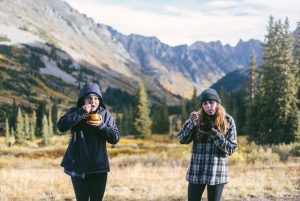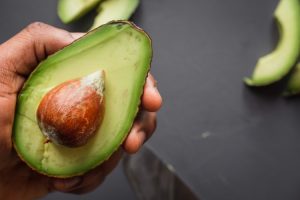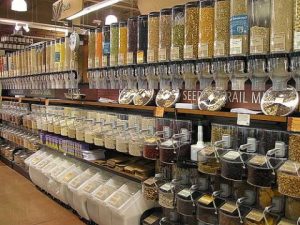When setting out for a backpacking trip, most people spend a lot of time searching for the best gear to bring and the ideal route to hike. These are definitely worthy of your time to set yourself upright for that awesome adventure in the woods. You want to feel at your best and strong in your body with comfortable gear, while also enjoying yourself to the max on a stellar trail.
If you want to feel good and perform at your best while backpacking, doesn’t it also make sense to think about the quality of the food you’re going to pack?
Don’t worry; healthy eating on the trail doesn’t have to be expensive, heavy, tasteless, or boring! Meal planning doesn’t have to be overwhelming either, and here we’re going to break things down in a simple way to support you in feeling optimal on your next adventure to the great outdoors. This article looks at the following four sections:
Quick Navigation:
Backpacking Food: Why It’s So Important To Get Nutrition Right

There is a saying many hikers hold as a mantra when loading up their backpacks: “Ounces equal pounds, and pounds equal pain.” The more stuff you carry, the more you will feel weighted down as you hike – it’s that simple. This can lead to soreness, achy joints, feet issues, and an overall bummed mood.
This mantra definitely applies to food choices. Ideally, a hiker aims to carry 1.5 – 2.5 pounds of food per day on a backpacking trip. Who wants to carry a whole bunch of extra food that serves little purpose to fuel your body?
Not all calories are created equal, and one of the most important things to consider when meal planning for a trip is: how much nutritional value is in this food? Is it worth the weight of carrying it because it will (or won’t) provide me with sustained endurance?
There are tons of lightweight food options out there; however, many of them are highly processed and filled with sugar. These quick fixes are often labeled as “empty calories,” meaning there is little to no nutritional value to benefit our bodies.
The bottom line is that you’re going to feel better if you eat better. Taking some time to build nutritional value into your trail diet will reward you with increased energy and less hiker hunger because you will be satisfied with high-calorie and nutrient-dense food.
Things To Consider When Choosing Your Backpacking Foods
If you’re on board with eating healthy while romping around in the woods, your food choices will ultimately be shaped by the following factors:
Calorie Intake
It takes a lot of energy to hike miles! Hikers can burn between 3,000-4,000 calories per day, but it really depends on how much you’re walking and the type of terrain. A thru-hiker pounding out 20-30 mile days can burn 5,000 or more calories. It’s a good idea to have a sense of your metabolism, so you know if you’re someone who needs to eat a lot. This can also depend on your age, weight, size, and activity output. It’s essential to pack in ample nutrients to give your body the energy it needs.
Weight to Nutrition Ratio
You are more likely to be in for the long haul if you have sustained, balanced energy and blood sugar levels. Eating complex carbohydrates, protein, fiber, and good fats will help you do this, where sugary, simple carbs won’t. Also think about how calorically dense your food choices are to keep your pack weight low. High-fat and high-protein foods like nuts and seeds, nut butters, jerky, protein powders and bars tend to have high calorie-per-ounce ratios. Sure, those Pop-Tarts may be loaded with calories; but that energy is going to burn real fast and perhaps leave you feeling a bit lethargic after. Remember to consider those empty calories when looking at calorie-to-ounce ratio, which can be around 120 calories to each ounce of weight.
Food Volume
Some food is bulkier than other kinds, and space can be at a premium when trying to organize your pack and keep it light. When looking at two foods that may have a similar nutrition profile, you may want to choose the one that takes up less space. A whole-grain bread may provide nutrients, but it takes up a lot of room! This is especially important on long journeys of several days when you have to carry a lot of food, and if a bear canister is required.
It’s usually helpful to take food out of its original packaging and organize it into Ziplock bags to save on space.
Food Storage
Storing your food properly is often overlooked when backpacking, even though it’s a way to protect wildlife and other hikers. Once animals like bears become conditioned to looking for your food, they are more inclined to visit campsites. This puts other hikers at risk, and also puts the bear in danger of being trapped and killed. Let’s also consider the ‘mini-bears’ as they are sometimes called rodents that love the idea of chewing through your $500 tent to get to your snacks.
Learn how to hang your food, use a bear canister, or store it in an odor-proof food bag.
Leave No Trace (LNT)
LNT means to leave a wilderness area the way you found it, without a single trace of you having been there. This doesn’t just mean your food wrappers; it also includes any compostable waste you may pack in, like banana peels or coffee grinds. Try to leave an area better than you found it if you do find the trash of a careless hiker. Read more here on the seven principles of LNT so you model excellent behavior while on trail for others to follow.
Convenience
That last thing you need is for eating to feel like a chore while backpacking. Ease and convenience are key, especially if you are hiking big mile days. This may vary with personal preference: some people are grazers and don’t mind hiking and eating at the same time; others like to sit down to eat, but don’t want it to be a huge process.
Keep it simple with foods that don’t take forever to cook, or try the cold-soak method which is popular amongst thru-hikers. Cold-soaking is when you just add water to meals, and let them soak while you hike or set up camp. Using any jar that doesn’t leak is great. This method also eliminates the need to carry a stove or fuel, helping to reduce pack weight.
Water
Be aware of how much water you need for meals, and decide whether you need to camp near a water source, or plan to carry extra for dry camping.
Fuel
Fuel usage truly varies per person: some hikers cook three meals a day plus coffee or tea, and some cook just one. If you’re relying on cooking to eat, be sure you have enough!
Backpacking Food Tips

Make a Meal Schedule
Making a meal schedule can be as simple as jotting on a piece of paper what you’ll eat for each meal, plus snacks. This also functions as a grocery list, so you’ve nailed two tasks at once. The biggest value of creating a meal schedule is that it can save you money and minimize the common problem of carrying excess food you don’t need. Don’t hesitate to take a little extra food though, in case of an emergency or if you happen to need an additional snack.

Variety is the Spice of Life
If you pack all the same food, it’s likely you won’t be super interested in eating. Eating can be such a big reward while on the trail, especially for a longer trip, so change it up! Pack what you know you like, and get a variety of textures and flavors. For example, crunchy foods like chips or crackers are a great addition to all the soups and soft dishes.
Throwing in some spices and condiments into your pack can do wonders to your food creations. Many grocery, health food stores, and co-op’s have bulk sections for spices: fill small amounts in little plastic bags of your favorite seasonings. They often have blends for Indian, Italian, and Middle Eastern food, so you don’t have to carry that many individual spices. You can also find single-serve packets of olive oil, coconut oil, hot sauce, and other popular condiments (mustard, mayo, relish, etc) to jazz up your grub.

Fresh Produce
Vegetables and fruit have poor calorie per ounce ratios, but they do hold nutritional value. If it’s not too warm, broccoli-carrot slaw will keep a few days, as will kale. Spinach is ultralight and can be used the first day out. An avocado may be worth the weight since it’s loaded with good fats. If you’re going on a short trip, having some fresh fare can add some fiber, vitamins, and minerals that other trail food lacks.
Treat Yourself

Yep, you can be healthy on the trail and still have treats! Enjoying some quality dark chocolate can be such a mood-boost after busting your butt up a mountain for a six-mile climb. There are lots of better alternatives to some of those classic treats out there, not loaded with artificial flavors, colors, or high fructose corn syrup. If you like M&M’s, try Sunspire brand (here on amazon). Peanut butter cups? Justin’s makes a delicious option sure to satisfy your sweet tooth (see on amazon here).

Cost, Saving Money, & Where to Shop
Fancy freeze-dried meals can be expensive at $8-14 a pop. These can be nice for a couple of days in the backcountry; but if you’re planning for a longer trip, there are other options that won’t break the bank.
Where you shop can depend on your budget and time. Certainly, you can get all of your food at an outfitter, yet it may be costly. Consider visiting the bulk section of a grocery, health food store, or co-op. There are loads of dry food combos in the form of soups, veggies, dehydrated beans, grains, and more. These are a fraction of the cost compared to freeze-dried meals, and they taste great! You can mix and match to make a similar creation with your handy-dandy spices. Dehydrating your own food is a healthy, cost-effective choice, although a bit time-consuming.
You can find nuts, seeds, dried fruit, granola, oats, crackers, chocolate – the list is infinite. Trader Joe’s has an awesome selection as well, and their prices are affordable. Shopping online for bulk supplies can additionally save your wallet.
Meal Suggestions & Ideas
Now let’s look at the nitty-gritty on healthy food ideas and meal planning while backpacking. These suggestions will incorporate what’s inexpensive, lightweight, creative, easy, and do-it-yourself.

Breakfast:
Do you like to pack up and go, or linger around camp for breakfast? This can determine what you eat. Here are some ideas; many of the items below can be found in a store’s bulk section:
- Oatmeal (bulk or in a packet), is a staple, either cooked or cold-soaked if you’re a stove-less. Add cinnamon and dried fruit for natural sweetness if you’re staying away from instant packets that are filled with sugar. Instant packs are great however since you can pour hot water directly in the packet.
- Nut butter (sunflower, peanut, almond, cashew) from a packet if you want to save on weight. Add to oats, or eat on its own if you’re on the go. Powdered peanut butter is easy to find, and is light to carry.
- Protein powder can be shaken in a water bottle for a fast meal, or add it to oatmeal or cereal for an extra boost.
- Flax seeds, hemp seeds, chia seeds, coconut flakes, and cacao nibs can fancy up oats and provide additional calories and nutrition.
- Dehydrated fruit is lightweight and can mix into other breakfast staples nicely.
- Granola and cereal – there are heaps of healthier alternatives in bulk or prepackaged at grocery stores. You can use powdered milk or powdered coconut milk; however, water works well if you don’t want to carry it.
- Powdered eggs in a tortilla (get creative with you spices and condiments) can pack a punch to start the day.
- Instant grits or polenta with jerky and cheese is a good one, if you like savory.
- Breakfast protein bars – Kind does well with theirs (here on Amazon); and other bars will be covered below with snacks.
- Coffee or tea is a must for some folks, and these can easily be bought in individual packets.
Lunch:

Most hikers opt for a cold lunch to save time and fuel usage. Here are some creations to try:
- A fish packet (tuna, salmon) mixed with condiments you like, some nuts, and dried fruit can make something like a ‘tuna salad ‘ concept for variety. You could also do this with a chicken packet, but it’s a bit heavier.
- Crackers or chips add crunch and flavor to anything; give sweet potato chips a whirl. Try dried seaweed which is incredibly lightweight, plus you get some dark green nutrients.
- A classic concoction is a tortilla and hard cheese, with salami or summer sausage. There are different options for tortillas, and Ezekiel makes an excellent sprouted one.
- Powdered hummus or beans can be mixed with a little water and put on a tortilla or crackers. Olive oil is a nice addition here, too.
- Bagels or pita bread are tasty with nut butter, jam, or honey packs; and cream cheese will last several days if it’s not so hot out.

Dinner:
After a long day, many hikers look forward to sitting down for a hot meal at dinner. Some hikers skip the hot meal though, as they’re put off by the effort of cooking and clean up. This is another reason cold-soaking can come in handy: you can soak a meal in your container while you’re walking, and then it’s ready to chow when you get to camp. Many of these ideas below could also be consumed for lunch, since everyone has different food preferences at varying times of day.
- Couscous is very versatile, and it can either be cold-soaked in your container, or it cooks in no time on a stove. You can buy flavored couscous by Near East, (on Amazon here) or DIY by adding your favorite spices and seasonings. Switch up spices to create unique flavor profiles (i.e. curry, garlic, garam masala for Indian flavor; ginger, garlic, lemongrass for Thai flavor; cumin, coriander, chili for Mexican, etc.). Nutritional yeast adds protein and gives it a cheesy flavor. Try adding trail mix with fruit and nuts, plus curry powder. Jerky packs protein and a savory bite.
- Dried veggies are light to carry and can also be soaked or cooked, added to your grain of choice. Instant rice and couscous welcome this!
- Noodles are a go-to on trail, which can be cold-soaked or heated up. These days, there are healthier alternatives to some of the cheap, popular brands that also don’t cost a fortune. Lotus Foods Rice Ramen and Mike’s Mighty Good are solid choices, but you will find a lot more brands even in the common grocery stores as people grow more health-conscious. Don’t forget to scan the international food aisles! Mix peanut butter powder and you’ve got backpacker Pad Thai.
- Bulk sections have many choices for dried soup mixes. Split pea, corn chowder, and black bean are filled with protein. If you want a pre-packaged brand, McDougall’s makes a variety of tasty soups and noodles with a good ingredients label.
- Try Annie’s Mac & Cheese for a better brand choice that’s not expensive. Jerky is extra yummy in here, too!
- The ‘just-add-boiling-water’ convenience of a more costly freeze-dried or dehydrated meal can be a real treat, and there is an abundance of good companies featured at your local outfitter or online.
Snacks & Drinks:

Hiking can be energy intensive, so an ample supply of snacks is important for both physical and mental stamina.
- Nuts, seeds, dried fruit, banana chips – buy prepackaged trail mix or make your own with your favorite sweet and salty combo.
- Fruit leather strips can be bought or dehydrated at home.
- Jerky comes in all flavors and you could even make it yourself. If you do buy it, avoid brands filled with nitrates and ingredients you can’t pronounce.
- Crackers, pretzels, sesame sticks, flax crisps, or other savory crunch foods can satiate a salt craving. You can find gluten-free and grain-free choices as well.
- Bars – Luna, ProBar, LaraBar, and Clif are favored choices. When looking for other bars, try to find ones with high protein and low sugar. Simple ingredients are best, versus weird ones you’ve never heard of.
- Chocolate covered nuts, fruit, or plain- you can’t go wrong with some chocolate. Try to stay away from candy bars filled with sub-par ingredients.
- Water is the ultimate way to hydrate, but you can also find drink powders with electrolytes, superfoods, and vital nutrients; Amazing Grass is one to check out. If you don’t mind using your stove, hot apple cider; chai; and hot chocolate can encourage you to get fluids into your body.
The main takeaway here is that eating healthy while backpacking doesn’t have to be dull or restrictive due to weight or cost. Lightweight, affordable, and tasty options abound; and like with choosing your gear, do what works for you and your body.
Heather Rideout has been a life-long outdoors woman. Her pursuits and passion with hiking and camping have taken her around the world for many long distance trips; such as backpacking in Nepal, India, South America, Morocco, Europe, and North America. Heather has hiked the Appalachian Trail, 2,250 miles of the Pacific Crest Trail, and a route of 1,500 miles combining several Camino routes through Spain and Portugal. She has been a blogger for ‘The Trek,’ and recorded an episode with one of her outdoor stories for the podcast ‘Out There.’ Heather shares some of her writing on her website, www.wanderyoga.com
-
Beauty
-
Parking
-
Trail Conditions
